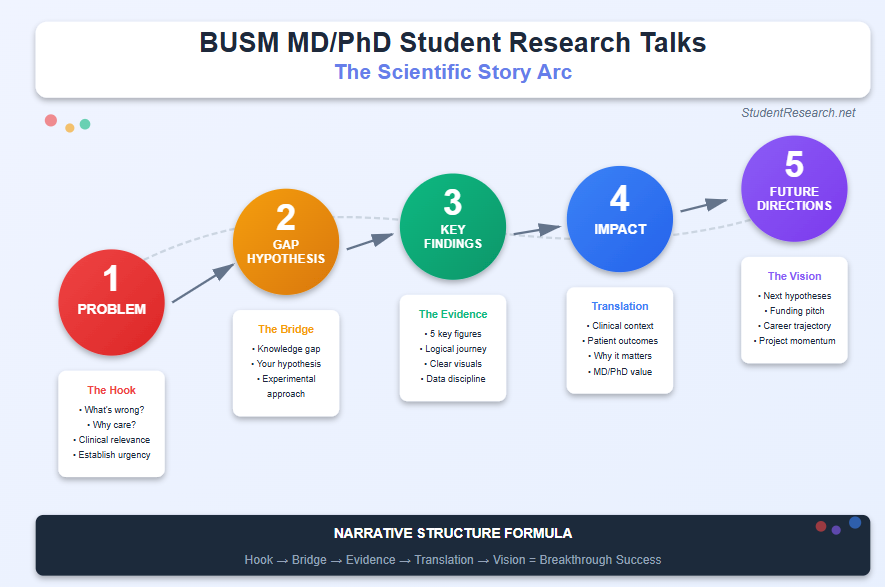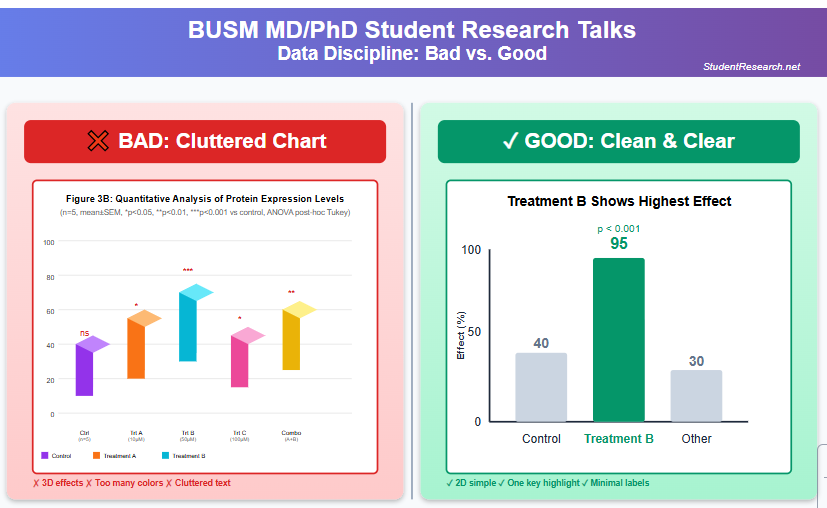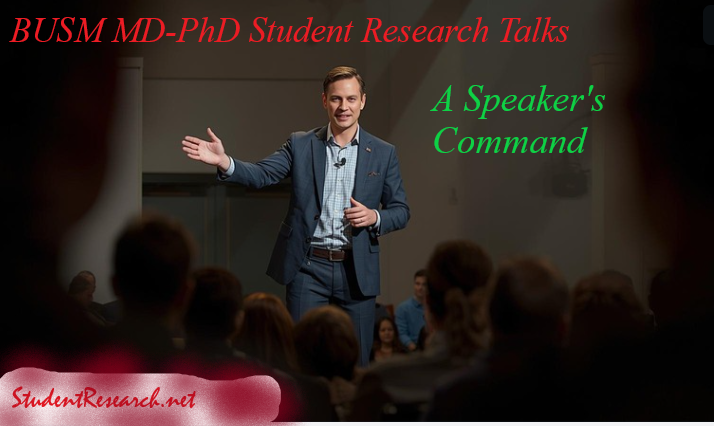Table of Contents
ToggleEarning a dual Doctor of Medicine (MD) and Doctor of Philosophy (PhD) degree at Boston University School of Medicine (BUSM) represents a rigorous academic pursuit. The presentation of your original Laboratory Research is not just a requirement; it is a critical performance opportunity. These high-stakes presentations determine faculty perception, guide feedback, and define your future career trajectory. Mastering your BUSM MD/PhD student research talks is essential for converting years of intense Graduate Education into immediate professional advancement. This definitive guide reveals 7 Essential Insights to elevate your next talk from a routine seminar to an ultimate breakthrough success.
How to Structure Your Scientific Narrative: The Core of BUSM MD/PhD Student Research Talks
Moving from the bench to the podium requires more than just sharing data; it requires strategic communication. This section details the critical components needed to build a narrative that is both scientifically rigorous and compelling to a diverse audience, ensuring your BUSM MD/PhD student research talks land effectively.
Why Storytelling is Essential for Scientific Breakthroughs
Your complex Laboratory Research must transition into engaging Dissertation Talks. Success in BUSM MD/PhD student research talks happens when you recognize your audience is broad. You must deliver a clear, simple narrative that consistently answers the crucial question, “why should I care?”
- Audience-Centric Narrative (Essential Insight 1): Frame your work not as a list of findings, but as a journey of discovery.
- The narrative structure captures attention and helps reviewers follow your logic.
- Simple, direct language ensures everyone, from clinicians to basic scientists, grasps the significance of your work.
- Treat every presentation as an opportunity to advocate for your research.
Mastering the “Why”: Crafting the Hook, Bridge, and Conclusion

The first minute of your presentation is the most crucial, setting the stage for all subsequent data interpretation. Mastering the “Why” ensures a strong start.
- The “Hook & Bridge” (Essential Insight 2): Secure immediate engagement by clearly stating the problem and the gap in current knowledge.
- Your structure must follow a defined arc: Problem, Gap, Hypothesis, Finding, and Impact.
- A strong emotional arc is required to hold the attention of faculty reviewers during BUSM MD/PhD student research talks.
- The structural flow is necessary to transition smoothly to the data.
- Use your initial slides to establish the foundational need for your research.
- A compelling conclusion should frame your findings in the largest possible context.
- This preparation elevates your Trainee Seminar from a presentation into a performance.
- Perfecting the opening ensures the rigor of your science is not lost on your audience during high-stakes BUSM MD/PhD student research talks.
Understanding the Unique Expectations of Academic Medicine
The dual audience of Academic Medicine and Biomedical Science faculty necessitates a hybrid talk. Your presentation must satisfy both the methodological skeptic and the clinical visionary.
- Success in BUSM MD/PhD student research talks demonstrates both methodological rigor and translational potential.
- Faculty expect to see both detailed experimental design and future clinical implications.
- Highlight the Translational Research pipeline that connects your findings to patient care.
- Presenting a hybrid talk proves you understand the intersection of your dual training.
- The audience at BUSM seeks evidence that you can navigate both the lab and the hospital environment.
Stuck on complex Biomedical Science concepts? StudentResearch.net connects you with PhD-level experts in your field. Get the rigor your Doctoral Candidate work demands. Stop settling for generic writing.
Visualizing Impact: Data, Jargon, and Scientific Communication in BUSM MD/PhD Student Research Talks
After establishing a compelling narrative, the next step involves converting complex experimental results into clear visual evidence. Data visualization and clarity are pivotal in distinguishing exceptional BUSM MD/PhD student research talks from merely adequate ones. The content herein offers guidance on the discipline required for impactful visual presentation.
Data Discipline: How to Choose the 5 Most Impactful Figures for Student Research

The tendency to include every piece of data is a common pitfall in Student Research. Effective Scientific Communication demands ruthless discipline in figure selection and simplification. Only the data essential for supporting the core conclusion should remain visible.
- Data Discipline (Essential Insight 3): Focus on quality over quantity; five impactful figures are better than twenty confusing ones.
- Simplify every visual element: remove unnecessary gridlines, excessive labels, and complicated legends.
- Ensure data visualization choices (e.g., bar charts, scatter plots) align precisely with the type of data being presented.
- Presenting clean figures immediately elevates the perceived quality of your research.
- Complex statistical analyses must be clearly explained, not just displayed, within the context of your BUSM MD/PhD student research talks.
- Every figure should advance the central argument of your presentation.
- This intense selectivity is a hallmark of successful BUSM MD/PhD student research talks at the graduate level.
- Use bold, high-contrast colors to guide the audience’s eye toward the key finding.
- Your goal is immediate comprehension, not subsequent deciphering.
What is the Logical Journey of an MD/PhD Doctoral Candidate?
Faculty and reviewers expect the Doctoral Candidate to do more than just report results; they want to see the thought process that led to them. This transparency is crucial for the assessment of critical thinking skills. Presenting the logical journey demonstrates intellectual maturity.
- The Logical Journey (Essential Insight 5): Guide the audience through your decision-making process, including challenges and pivots.
- Explain why one assay failed and how that led you to the subsequent, successful experiment.
- This insight into your thought process satisfies the high expectations of GMS faculty.
- Showing methodological rigor validates the conclusions drawn from your results.
- Trainee Seminar attendees want evidence of intellectual depth, not just a perfect result.
- Frame the talk as a demonstration of critical thinking, which is a core expectation for all BUSM MD/PhD student research talks given at this level.
- Revealing your journey allows the audience to trust your methods completely.
- This level of honesty and reflection is critical for high-level BUSM MD/PhD student research talks.
Eliminating Jargon: Best Practices for Clarity
Jargon acts as a barrier to effective Scientific Communication, excluding many audience members. While technical language is sometimes necessary, excessive use of acronyms and field-specific shorthand dilutes your impact.
- Focus on actionable tips for reducing acronyms and hyper-specific technical language.
- Use the “explain it to a medical student” rule to gauge clarity and simplicity.
- Clarity is paramount for the diverse audience attending BUSM MD/PhD student research talks.
- Define every acronym upon its first use, then use it sparingly thereafter.
- Do not assume prior knowledge of highly specialized pathways or proteins.
- Substitute complex scientific terms with simpler, universally understood equivalents when possible.
- Clear language ensures your breakthrough message is heard by everyone.
- These best practices guarantee maximum impact for your BUSM MD/PhD student research talks.
Tired of hidden fees inflating your project cost? StudentResearch.net offers transparent, all-inclusive pricing! Your price includes formatting, citations (APA, MLA, etc.), and a plagiarism report. See the final cost now!
3. Why Translational Relevance Drives Your Scientific Career and Research Funding
Transitioning from data presentation to discussing real-world impact is the signature move of a physician-scientist. Your ability to connect laboratory findings to patient outcomes directly influences faculty review and future funding potential. By now, you are aware that translational research is non-negotiable for successful BUSM MD/PhD student research talks.
Unlocking Your Dual-Degree Advantage: The Clinical-Translational Context
The Dual-Degree Program grants you a unique, powerful perspective that basic science PhDs lack: the ability to frame disease from the bedside back to the bench. Successfully leveraging this clinical-translational context is essential.
- Clinical-Translational Context (Essential Insight 4): Synthesize your Medical Training and basic science findings seamlessly in the talk.
- Define the strategic value of your Dual-Degree Program early in the presentation.
- Discuss how successful BUSM MD/PhD student research talks leverage this synthesis for maximum impact.
- Ensure a dedicated segment focuses on the direct Translational Research implications of your findings.
- Explicitly state the relevance of your research to clinical practice or unsolved medical problems.
- Physician-scientists must demonstrate the capacity to bridge these two worlds effectively.
- Your talk should highlight a novel pathway to patient care, showcasing your dual expertise.
- Failure to emphasize the clinical angle undervalues your unique position within the MD/PhD structure.
- This connection is the core strength demonstrated in high-level BUSM MD/PhD student research talks.
Future Forward: Connecting Findings to New Research Funding Opportunities
The conclusion is not merely a summary; it is the early pitch for your next project, serving as an incubator for future Research Funding. Reviewers assess your Scientific Career trajectory based on your vision.
- “Future Forward” (Essential Insight 6): Frame the results for future Grant Writing, demonstrating a clear path forward.
- Explain the strategic importance of the “Future Directions” slide as a foundational pitch for funding.
- Use your findings to propose novel, high-impact hypotheses for the next phase of work.
- The best BUSM MD/PhD student research talks anticipate and preemptively answer questions about subsequent funding.
- Your presentation should clearly demonstrate that your project has momentum beyond the current scope.
- Offer advice on structuring the conclusion to maximize Research Funding appeal.
- This final segment demonstrates the talk’s direct role in launching a successful Scientific Career.
- Show the audience that your work is not an end, but a vital beginning.
- Secure your next project by presenting a powerful vision during BUSM MD/PhD student research talks.
What are the Next Steps After a Successful Research Talk?
The successful delivery of your research is only the first part of maximizing the opportunity. Strategic follow-up is necessary for networking, securing mentorship, and Unlocking collaborations.
- Discuss the essential follow-up actions immediately after the Q&A session concludes.
- Leveraging the talk for networking and collaboration accelerates career progress.
- Use the term “Unlocking” your professional network by following up with interested faculty members.
- Email reviewers with promised data or papers to maintain momentum and visibility.
- Emphasize that the applause at the end of BUSM MD/PhD student research talks is the start of the next professional phase.
- Seek critical feedback from non-committee members to refine your Scientific Communication skills further.
- Schedule meetings with key faculty whose questions demonstrated genuine interest.
- These post-talk steps transform a single event into a lasting professional gain.
Thesis due in 12 hours? Never miss a submission deadline again! StudentResearch.net guarantees on-time delivery, even for urgent Grant Writing and research requests. Reliability is our core promise to you.
How to Command the Room: Delivery, Q&A, and Thesis Defense Preparation
The final test of any MD/PhD research project is the live presentation. This section covers the physical and mental strategies needed to master your stage presence and handle the inevitable scrutiny of the Q&A session, preparing you for your ultimate Thesis Defense.
Mastering Presentation Delivery and Timing

Effective delivery is more than just reading slides; it involves non-verbal communication and precision timing. These practical mechanics determine whether your audience retains your crucial scientific message.
- Delivery & Command (Essential Insight 7, Part 1): Focus on body language, voice projection, and making eye contact.
- Your stage presence must reflect the confidence and rigor of your research.
- Tight timing is non-negotiable; practice transitions to ensure you hit all markers.
- Use a remote or clicker effectively to maintain control and movement.
- Avoid reading from the slide; speak extemporaneously from your notes.
- This final polish is crucial preparation for your full Thesis Defense.
- Successful BUSM MD/PhD student research talks feel conversational, not rehearsed.
How to Anticipate and Conquer the Toughest Q&A
The Q&A session is often the most stressful part, but it is also the best opportunity to demonstrate your critical thinking and depth of knowledge. Preparation is the key to conquering this challenge.
- Delivery & Command (Essential Insight 7, Part 2): Strategies for preparing “rehearsal slides” with backup data are vital.
- Develop backup slides for expected methodological or statistical questions.
- Focus on the graceful art of saying “I don’t know” while redirecting the query to what you do know.
- Never be defensive; treat every question as an opportunity to clarify or expand your research.
- Rehearse answering questions with peers who actively try to poke holes in your data.
- Three FPs are used here to reinforce the challenge of a high-stakes Q&A session after BUSM MD/PhD student research talks.
- Listen carefully to the entire question before formulating your response.
- Mastering the Q&A is the final hurdle in your highly scrutinized BUSM MD/PhD student research talks.
Conclusion
Your BUSM MD/PhD student research talks represent the pinnacle of your Graduate Education—the crucial bridge between the lab and the clinical setting. By Mastering 7 Essential Insights related to narrative structure, data visualization, clinical context, and delivery, you transform a required presentation into a career Unlocking moment. These techniques ensure you command the room, secure vital feedback, and build the foundation for future Research Funding. Remember, a well-delivered presentation at BUSM is the most powerful tool for advancing your Scientific Career and achieving ultimate success as a physician-scientist.
FAQs: Frequently Asked Questions on BUSM MD/PhD Student Research Talks
Here are common questions that MD/PhD students often face when preparing for their high-stakes BUSM MD/PhD student research talks:
- Q:How much time should I spend on the background section?
- A: Spend no more than 10-15% of your total time. Your audience is specialized; focus on the immediate gap, not general knowledge.
- Q:Should I include all my negative data?
- A: Only include negative data if it profoundly affected your experimental design (The Logical Journey), not simply to show volume of work.
- Q:What is the best way to handle a question I don’t know the answer to?
- A: Acknowledge the question’s validity, state you don’t have the data yet, and suggest a future experiment to address it (“Future Forward”).
- Q:What is the difference between a student research talk and a conference talk?
- A: The student talk focuses heavily on methodology and process (Logical Journey), while a conference talk focuses on breadth of findings and clinical impact.
- Q:How many slides is too many for a 45-minute talk?
- A: A maximum of 30-35 slides, assuming two minutes per slide for content and 15 minutes reserved for Q&A.
- Q:How do I make my figures readable for the whole audience?
- A: Use large, bold font sizes (24pt minimum) and high-contrast color palettes (Data Discipline).
- Q:What’s the most common mistake made during BUSM MD/PhD student research talks?
- A: Overloading slides with text and failing to clearly articulate the translational significance of the findings (Clinical-Translational Context).